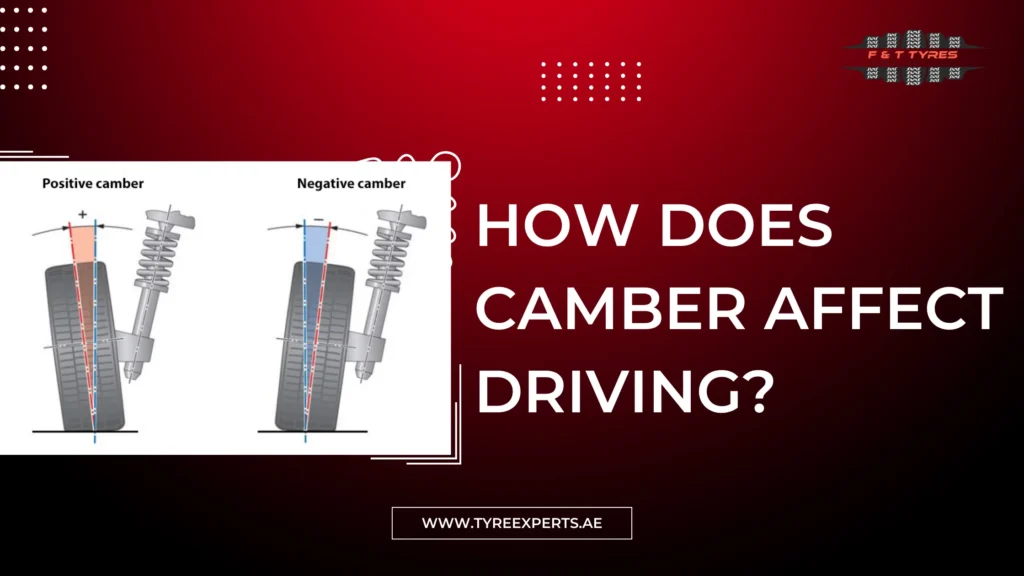When it comes to driving, the performance and safety of your vehicle are paramount. However, one aspect that often goes unnoticed by many drivers is the camber of their tyres. Camber refers to the angle at which your tyres tilt with the road surface. This seemingly minor detail can have a significant impact on how your car handles, its tyre wear, and overall driving experience. Understanding how camber affects driving can help you make informed decisions about your vehicle’s maintenance and performance optimization. In this article, we’ll explore what camber is, how it affects driving, and what you need to know to ensure your vehicle is in top condition.
What Is Camber And Why Does It Matter?
Camber is the angle of your car’s wheels about the road when viewed from the front or rear of the vehicle. If the top of the wheel tilts inward toward the car, it’s called a negative camber. If it tilts outward, it’s a positive camber. Camber is essential because it affects tyre contact with the road, influencing how your car handles corners, maintains stability, and how evenly your tyres wear over time. By understanding camber, you can see why it’s a critical factor in both everyday driving and high-performance situations.
How Does Camber Affect Tyre Wear?
One of the most direct impacts of camber on driving is tyre wear. When your camber is out of alignment, your tyres may not make uniform contact with the road surface. This uneven contact can cause specific parts of the tyre to wear out faster than others. For example, excessive negative camber can lead to the inner edge of your tyres wearing out quicker, while positive camber can cause the outer edge to deteriorate. If not corrected, improper camber can shorten the lifespan of your tyres and increase your costs over time.
Read More At: Positive Camber Vs Negative Camber
What Are The Driving Conditions Where Camber Is Most Important?
Camber becomes especially crucial in certain driving conditions. For instance, if you frequently drive on winding roads or take sharp turns, the camber setting of your tyres can significantly affect how well your car grips the road. Negative camber, which is often preferred for performance vehicles, improves grip during cornering because the tyre remains in better contact with the road surface. On the other hand, vehicles primarily used for straight-line driving may benefit from a neutral or slightly positive camber to reduce tyre wear and improve stability.
Why Is Proper Camber Adjustment Necessary?
Proper camber adjustment is necessary for maintaining your vehicle’s performance and safety. Misaligned camber can lead to poor handling, increased tyre wear, and even reduced fuel efficiency. This is why regular alignment checks are essential, especially if you notice uneven tyre wear or experience difficulties in handling your vehicle. Additionally, adjusting camber is not just about improving performance; it’s also about ensuring that your vehicle operates safely under various driving conditions.
How Can You Tell If Your Camber Is Out Of Alignment?
There are a few signs that your camber might be out of alignment. First, inspect your tyres for uneven wear patterns. If one side of the tyre is wearing out faster than the other, it could indicate a camber issue. You may also notice that your car pulls to one side while driving, especially if you’re on a flat, straight road. Another sign could be reduced stability when turning or an overall lack of smoothness in your driving experience. If you notice any of these issues, it may be time to have your vehicle’s alignment checked by a professional.
What Steps Can You Take To Correct Camber Issues?
Correcting camber issues typically involves a professional alignment service. During an alignment, a technician will adjust the angle of your wheels to ensure they are within the manufacturer’s recommended settings. If your vehicle has adjustable camber settings, this process will include fine-tuning the angle for optimal performance and tyre longevity. It’s also important to maintain regular alignment checks as part of your vehicle’s routine maintenance, especially if you frequently drive on rough roads or have had a recent impact, such as hitting a pothole or curb.
Conclusion
Camber plays a vital role in how your vehicle handles, how quickly your tyres wear, and your overall driving experience. Understanding the impact of camber on your driving can help you make more informed decisions about your vehicle’s maintenance and performance optimization. Regularly checking and adjusting your camber alignment ensures that your car operates safely and efficiently, providing you with a smoother and more enjoyable driving experience.
FAQ’s
How Often Should I Check My Vehicle’s Camber Alignment?
It’s recommended to check your vehicle’s camber alignment at least once a year or every 12,000 miles, whichever comes first. You should also have it checked if you notice uneven tyre wear or handling issues.
Can I Adjust The Camber Myself?
Adjusting camber typically requires specialized equipment and knowledge, so it’s best to leave this to a professional mechanic who can ensure it’s done correctly.
Does Camber Affect Fuel Efficiency?
Yes, improper camber can lead to increased rolling resistance, which can negatively impact fuel efficiency. Correct camber alignment helps maintain optimal contact between the tyre and the road, improving fuel efficiency.
What Is The Difference Between Camber And Caster?
Camber refers to the tilt of the wheels, while caster refers to the angle of the steering pivot. Both are important for alignment, but they affect different aspects of handling and stability.
Will Camber Adjustment Improve My Car’s Cornering Ability?
Yes, adjusting camber, particularly to a more negative setting, can improve your car’s grip during cornering, enhancing its overall handling and performance on winding roads.



